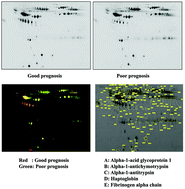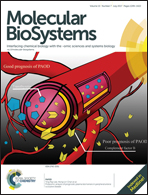Proteomic analysis of prognostic plasma biomarkers in peripheral arterial occlusive disease†
Abstract
Peripheral arterial occlusive disease (PAOD), one of the major manifestations of systemic atherosclerosis, causes intermittent claudication and rest pain. Patients with PAOD not only have reduced quality of life, but also have a substantial risk of cardiovascular morbidity and death. In this study, we adopted a proteomics-based approach using 2D-DIGE and MALDI-TOF MS to compare the differential plasma proteome between good and poor prognosis of PAOD. We identified 196 plasma proteins, which represent 42 unique gene products. These proteins mainly have roles in the inflammatory response and coagulation. This approach identified several potential prognostic plasma markers in PAOD, including transthyretin and complement factor B, which may be associated with the evaluation of good/poor prognosis of PAOD. In conclusion, we report a comprehensive patient-based plasma proteomic approach for the identification of potential plasma biomarkers for the screening and detection of good/poor prognosis of PAOD. Among these, transthyretin and complement factor B are potential markers for monitoring the PAOD disease in the plasma.



 Please wait while we load your content...
Please wait while we load your content...